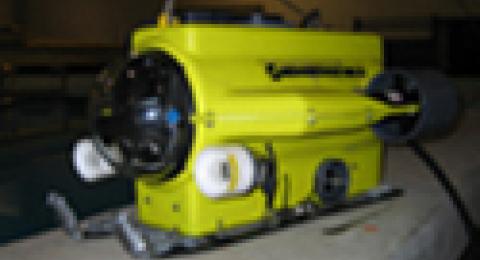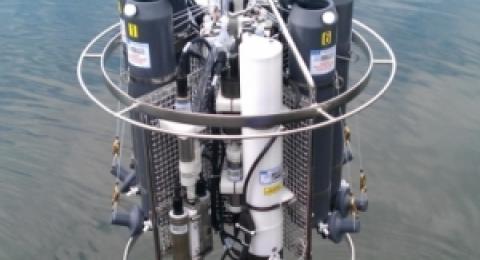Facilities
New Hampshire Sea Grant’s AquaFort serves as an offshore aquaculture training platform and research site. The AquaFort research program recruited local fishermen and farmers from NH, ME, and MA to participate in workshops and daily operations of an offshore aquaculture farm.
Learn More
Sustainable Seafood Center
Surface-controlled, self-propelled ROV with video camera. Operates to depths of up to 500 feet.
Learn More
Learn More
Equipment
The Jere A. Chase Ocean Engineering Laboratory, built in 1994, is home to the Center for Ocean Engineering and the headquarters for the Center for Coastal and Ocean Mapping/Joint Hydrographic Center (CCOM/JHC).
Learn More
Center for Ocean Renewable Energy
The system includes a Sea-Bird Electronics (SBE) 25Plus CTD, an SBE-55 Sampling Rosette with six four-liter Niskin bottles, a dedicated Hawboldt Industries SPR 1424/S Science winch, and a SBE-33 real-time monitoring and sampling deck unit.
Learn More
Equipment
At 300 feet long, the new Flow Physics Facility (FPF) is the world’s largest scientific quality boundary-layer wind tunnel facility. It will help engineers and scientists better understand the dynamics of turbulent boundary layers, informing the aerodynamics of situations such as atmospheric wind over the ocean, the flow of air over a commercial airplane or of sea water over a submarine.
Learn More
Center for Ocean Renewable Energy
Jackson Estuarine Laboratory (JEL) is located five miles from the Durham campus on the shores of Great Bay Estuary, one of the largest estuaries in northern New England.
Learn More
Center for Ocean Renewable Energy
The Judd Gregg Marine Research Complex (Marine Complex) supports research, education, and outreach in all aspects of marine biology, oceanography, and ocean engineering, with particular emphasis on marine biology and ecology, aquaculture, acoustics and ocean mapping, invasive species, autonomous surface vehicle research (ASV), ocean acidification, and renewable energy.
Learn More
Center for Ocean Renewable Energy
The 50-foot R/V Gulf Challenger is the flagship of the School of Marine Science and Ocean Engineering.
Learn More
Center for Ocean Renewable Energy
R/V Gulf Surveyor is a state-of-the-art platform for hydrographic research.
Learn More
Vessels
A majority of the UNH small boat fleet is located at the Jackson Estuarine Laboratory (JEL) and the Judd Gregg Marine Research Complex.
Learn More
Vessels
The UNH Tidal Energy Test Site at the General Sullivan Bridge is where the Lower Piscataqua enters Little Bay through a constriction. The tidal range is nominally 8.2 ft (2.5 m), and approximately 40 percent of the volume of Great Bay flows under the bridge every tidal cycle. This results in peak current speeds of greater than 4 knots (2 m/s), as well as relatively short periods of slack water and a steep current speed ramp-up. UNH-CORE faculty have modeled the dynamics of this tidal system in several studies.
Learn More
Center for Ocean Renewable Energy
The Memorial Bridge "The Living Bridge" is located in Portsmouth, NH. The bridge is instrumented with sensors that capture structural performance, traffic patterns, environmental conditions, the behavior of innovative bridge design elements and enable and promote community engagement. The information collected with these sensors is shared with researchers, bridge designers and the bridge owner, but also, where appropriate, with K-12 classrooms and the public.
Learn More
Center for Ocean Renewable Energy
The wave energy test site is located at the UNH Atlantic Marine Aquaculture (AMAC) site, which covers an area of 30 acres in 170 ft (52 m) of water approximately 6 miles from the New Hampshire coast. It has been successfully deployed under extreme New England winter conditions as a demonstration site for open ocean aquaculture for the past 10 years. The site has a subsurface mooring system and a large feed buoy (AMAC) is available as a useable platform and a potential end user load for any wave energy extraction device.
Learn More
Center for Ocean Renewable Energy













